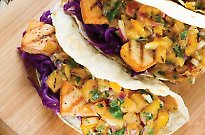
How to become vegan

6 tips for a smooth transition
Becoming vegan is not as hard as you think. Ruth Friedlander shares some tips and recipes to make the transition easier.
If you’ve decided to take the plunge and adopt a vegan diet – or even a partial vegan diet – congratulations for investigating and committing to an alternative way of eating while eschewing the well-worn path that most others choose to travel. While it can be a tough balancing act, once you get it right you’ll feel immensely rewarded and pleased with yourself for sticking to your guns and achieving your goal in a society that mainly caters to meat, dairy and egg consumers.
You may have decided to banish animal products for environmental (farming and deforestation for agriculture is a major contributor to global warming and climate change), ethical (dairy cows are forced to become pregnant year after year in order to keep up milk supply, with most of their male bobby calves being sent to slaughter shortly after birth) and/or health reasons (Bill Clinton became a vegan in 2010 in order to improve his heart health, and many celebrities and sports stars have since followed suit). Whatever the reason, it is a commendable move; however, in order to keep up the change, there are a few things you’ll need to take into consideration.
While I am not a nutritionist and in no way the authority on vegan eating, as a conscious consumer who tries to avoid excess consumption of animal products, and the friend of many a vegan, I have picked up a few great pieces of advice along the way. This list of tips and tricks is nowhere near exhaustive but it may just help get you off to a good start on your cruelty-free journey.
1. Vitamins and nutrients are top priority
Getting all the vitamins and nutrients your body needs is top priority when cutting out whole food groups such as meat, eggs and dairy. You can easily end up lacking in protein, iron, calcium, B12 and omega-3 if you aren’t careful with your planning. Research the foods you’ll need to regularly consume to get all the nutrition your body needs, and get regular health checks. You may find you need to supplement certain vitamins from time to time.
2. Eat a variety of foods
Keep things interesting at mealtimes - check out the healthy eating aisle of your supermarket, gourmet stores and health food shops for inspiration. You may find seeds, grains and legumes you’ve never cooked with before. Search online for recipes and ways to incorporate these new foods into your diet.
3. Find cruelty-free replacements
While I don’t recommend using them on a daily basis, you can find a cruelty- free replacement of just about any meat or dairy product you may crave from time to time. Fake bacon, chicken nibbles, sandwich meats and different cheeses are all readily available. Have a look in the vegetarian section of your local supermarket, in health food stores, chinese groceries or even online.
4. Choose Asian, African and Indian restaurants when dining out
When eating out, head for Asian, African and Indian restaurants for a variety of options – many vegetarian dishes also be vegan by default. Don’t be afraid to ask if meals are prepared using animal products and to request changes to dishes to fit in with your diet if necessary. Just be reasonable and don’t go asking the chef to de-meat his meatloaf!
5. Plan ahead
Plan ahead if you are taking a road trip. Many service stations and takeaway joints won’t cater to vegans, so pack sandwiches, fruit and nuts for the journey. You’ll probably find yourself in a better culinary position than your travelling partners, who have to resort to soggy ‘servo’ egg sandwiches.
6. Be inventive
Spend time collating recipes that you can turn to when in need of inspiration. The internet is full of great vegan recipes, from ethnic cuisine to childhood favourites such as macaroni cheese, lasagna and cupcakes. Keep an open mind and a well-stocked pantry and you’ll never feel like you are missing out.
Author: Ruth Friedlander; Photo credit: Jessica Symonds


